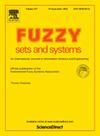供应链系统中无变量最小积模糊关系不等式及其加权最大最小优化
IF 2.7
1区 数学
Q2 COMPUTER SCIENCE, THEORY & METHODS
引用次数: 0
摘要
本文主要研究具有任意1个缺失变量的最小积模糊关系不等式(FRIs),以解决供应链系统中的定价问题和考虑突发因素。我们首先定义了l+1维路径(简称为(l+1)−D路径),并给出了与相应解相关的一些性质。提出了一种基于(l+1)−D路径的fri系统求解算法。验证了FRIs系统的完整解集完全由唯一最小解和有限(l+1)−D路径解决定。在此基础上,建立了具有任意l个缺失变量的最小积fri的加权最大最小优化问题。提出了一种基于加权最优(l+1)−D路径的多项式时间复杂度算法,以获得最优解和目标值。此外,我们进一步描述了所建立的加权最大最小优化问题的完全最优解集。算例说明了算法的可行性和简便性。本文章由计算机程序翻译,如有差异,请以英文原文为准。
Min-product fuzzy relation inequalities with absent variables and their weighted max-min optimization in supply chain system
We mainly investigate the min-product fuzzy relation inequalities (FRIs) with arbitrary l absent variables to address the pricing issue and account for sudden factors in the supply chain system. We first define the dimensional path (abbreviated as path), and provide some properties related to the corresponding solutions. An algorithm based on the path is proposed to solve the FRIs system. It is verified that the complete solution set of the FRIs system is entirely determined by the unique minimum solution and the finite path solution. Then we also establish a weighted max-min optimization problem subject to min-product FRIs with arbitrary l absent variables. An algorithm with polynomial time complexity based on the weighted optimal path is developed to obtain the optimal solution and objective value. More, we further characterize the complete optimal solution set to our established weighted max-min optimization problem. Several numerical examples are presented to illustrate the feasibility and simplicity of our developed algorithm.
求助全文
通过发布文献求助,成功后即可免费获取论文全文。
去求助
来源期刊

Fuzzy Sets and Systems
数学-计算机:理论方法
CiteScore
6.50
自引率
17.90%
发文量
321
审稿时长
6.1 months
期刊介绍:
Since its launching in 1978, the journal Fuzzy Sets and Systems has been devoted to the international advancement of the theory and application of fuzzy sets and systems. The theory of fuzzy sets now encompasses a well organized corpus of basic notions including (and not restricted to) aggregation operations, a generalized theory of relations, specific measures of information content, a calculus of fuzzy numbers. Fuzzy sets are also the cornerstone of a non-additive uncertainty theory, namely possibility theory, and of a versatile tool for both linguistic and numerical modeling: fuzzy rule-based systems. Numerous works now combine fuzzy concepts with other scientific disciplines as well as modern technologies.
In mathematics fuzzy sets have triggered new research topics in connection with category theory, topology, algebra, analysis. Fuzzy sets are also part of a recent trend in the study of generalized measures and integrals, and are combined with statistical methods. Furthermore, fuzzy sets have strong logical underpinnings in the tradition of many-valued logics.
 求助内容:
求助内容: 应助结果提醒方式:
应助结果提醒方式:


